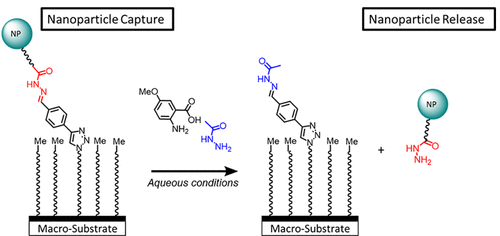当前位置:
X-MOL 学术
›
Bioconjugate Chem.
›
论文详情
Our official English website, www.x-mol.net, welcomes your feedback! (Note: you will need to create a separate account there.)
Capture and Release of Protein-Nanoparticle Conjugates by Reversible Covalent Molecular Linkers.
Bioconjugate Chemistry ( IF 4.7 ) Pub Date : 2020-07-30 , DOI: 10.1021/acs.bioconjchem.0c00372 Isaac W Moran 1 , Melissa M Sprachman 1 , James L Bachman 2 , Samuel D Dahlhauser 2 , Eric V Anslyn 2 , David J D Carter 1
Bioconjugate Chemistry ( IF 4.7 ) Pub Date : 2020-07-30 , DOI: 10.1021/acs.bioconjchem.0c00372 Isaac W Moran 1 , Melissa M Sprachman 1 , James L Bachman 2 , Samuel D Dahlhauser 2 , Eric V Anslyn 2 , David J D Carter 1
Affiliation

|
A hybrid approach to covalently detachable molecules for nanoparticle capture and release from several custom-functionalized surfaces is described. This new surface chemistry capability provides a means for reversible binding of functionalized nanoparticles without relying on costly nucleic acid-based complexation. A new surface linker motif was devised wherein custom molecules were synthesized with components for surface anchoring, cleavage, and target capture through biotin–streptavidin binding. All capture-and-release chemistry is performed using physiological conditions (aqueous, pH 7). Covalent cleavage of linker molecules was achieved through incorporation of a tunable orthogonal reversible covalent (TORC) hydrazone functional group which underwent exchange with a competitive hydrazide aided by an aniline catalyst. The influence of the linker architecture on hydrazone exchange and nanoparticle release was probed by altering the distance between hydrazone and biotin groups using different length PEG spacers. Cleavable linkers were used to functionalize microwells, magnetic separation beads, and gold-coated glass surfaces. Upon functionalization, all surface types bound streptavidin and conjugated nanoparticles regardless of the linker structure. Conversely, the extent of hydrazone exchange as well as release of nanoparticles were influenced both by the hydrazone surface density and the linker molecular structure.
中文翻译:

通过可逆共价分子接头捕获和释放蛋白质-纳米粒子缀合物。
描述了一种共价可分离分子用于纳米粒子捕获和从几个定制功能化表面释放的混合方法。这种新的表面化学功能提供了一种功能化纳米粒子可逆结合的方法,而无需依赖昂贵的基于核酸的络合。设计了一种新的表面连接基序,其中合成了自定义分子,以及通过生物素-链霉亲和素结合进行表面锚定,切割和靶标捕获的成分。所有捕获和释放化学都是在生理条件(水溶液,pH 7)下进行的。接头分子的共价裂解是通过引入可调节的正交可逆共价(TORC)functional官能团实现的,该官能团与苯胺催化剂辅助的竞争性酰肼进行交换。通过使用不同长度的PEG间隔基改变与生物素基团之间的距离,探讨了连接结构对交换和纳米粒子释放的影响。可切割的接头用于功能化微孔,磁分离珠和镀金玻璃表面。官能化后,所有表面类型均会结合链霉亲和素和共轭纳米颗粒,而与接头结构无关。相反,的交换程度以及纳米颗粒的释放都受到zone表面密度和接头分子结构的影响。磁选珠和镀金玻璃表面。官能化后,所有表面类型均会结合链霉亲和素和结合的纳米颗粒,而与接头结构无关。相反,的交换程度以及纳米颗粒的释放都受到zone表面密度和接头分子结构的影响。磁选珠和镀金玻璃表面。官能化后,所有表面类型均会结合链霉亲和素和结合的纳米颗粒,而与接头结构无关。相反,的交换程度以及纳米颗粒的释放都受到zone表面密度和接头分子结构的影响。
更新日期:2020-09-16
中文翻译:

通过可逆共价分子接头捕获和释放蛋白质-纳米粒子缀合物。
描述了一种共价可分离分子用于纳米粒子捕获和从几个定制功能化表面释放的混合方法。这种新的表面化学功能提供了一种功能化纳米粒子可逆结合的方法,而无需依赖昂贵的基于核酸的络合。设计了一种新的表面连接基序,其中合成了自定义分子,以及通过生物素-链霉亲和素结合进行表面锚定,切割和靶标捕获的成分。所有捕获和释放化学都是在生理条件(水溶液,pH 7)下进行的。接头分子的共价裂解是通过引入可调节的正交可逆共价(TORC)functional官能团实现的,该官能团与苯胺催化剂辅助的竞争性酰肼进行交换。通过使用不同长度的PEG间隔基改变与生物素基团之间的距离,探讨了连接结构对交换和纳米粒子释放的影响。可切割的接头用于功能化微孔,磁分离珠和镀金玻璃表面。官能化后,所有表面类型均会结合链霉亲和素和共轭纳米颗粒,而与接头结构无关。相反,的交换程度以及纳米颗粒的释放都受到zone表面密度和接头分子结构的影响。磁选珠和镀金玻璃表面。官能化后,所有表面类型均会结合链霉亲和素和结合的纳米颗粒,而与接头结构无关。相反,的交换程度以及纳米颗粒的释放都受到zone表面密度和接头分子结构的影响。磁选珠和镀金玻璃表面。官能化后,所有表面类型均会结合链霉亲和素和结合的纳米颗粒,而与接头结构无关。相反,的交换程度以及纳米颗粒的释放都受到zone表面密度和接头分子结构的影响。



























 京公网安备 11010802027423号
京公网安备 11010802027423号